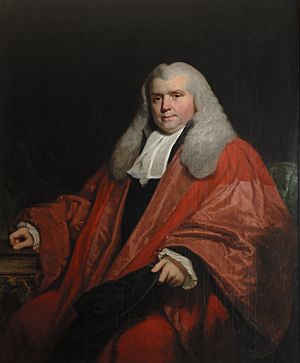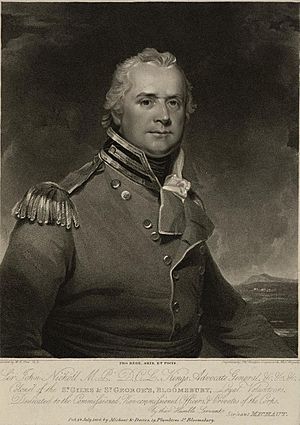John Nicholl (judge) facts for kids
Quick facts for kids
Sir John Nicholl
|
|
|---|---|
 |
|
| Member of Parliament for Penryn |
|
| In office 1802–1806 |
|
| Member of Parliament for Hastings |
|
| In office 1806–1807 |
|
| Member of Parliament for Great Bedwyn |
|
| In office 1807–1832 |
|
| Personal details | |
| Born |
John Nicholl
16 March 1759 Llan-maes, Wales |
| Died | 26 August 1838 (aged 79) Merthyr Mawr, Wales |
| Nationality | British |
| Political party | British Tory party |
| Alma mater | St John's College, Oxford |
Sir John Nicholl (born March 16, 1759 – died August 26, 1838) was an important Welsh figure. He was a Member of Parliament (MP) and a respected judge. People knew him for being very fair and having strong, good judgment in his legal decisions.
Contents
Sir John Nicholl's Early Life
John Nicholl was born in 1759. He was the second son of John Nicholl, who lived in Llan-maes. This is a small village near Llantwit Major in Wales.
He went to school in Cowbridge and Bristol. In 1775, he started studying at St John's College, Oxford. He earned his first law degree in 1780. Then, in 1785, he got a higher law degree. That same year, he became a lawyer at the Doctors' Commons.
A Career in Law and Politics
John Nicholl became a very busy lawyer. In 1798, he took over from Sir William Scott as the King's Advocate. This was an important legal job. When he got this role, he was made a knight, which was a common tradition. As King's Advocate, Nicholl often advised the Privy Council and the Secretary of State on rules about different countries.
Serving as an MP
In 1802, Nicholl was elected to Parliament. He represented the area of Penryn in Cornwall. From 1806 to 1807, he was the MP for Hastings.
After that, he was elected to represent Great Bedwyn. He stayed an MP for this area until 1832. This was when a new law, the Reform Act, changed how Parliament worked. After this, he retired from politics. Nicholl was a strong member of the Tory party. He was against changing Parliament and giving more rights to Roman Catholics.
Important Judicial Roles
In 1809, Nicholl became the Dean of the Arches. This was a top judge in the Church of England's legal system. He also joined the Privy Council and became a judge in the Prerogative Court of Canterbury.
Later, in 1833, Nicholl was made a judge of the High Court of Admiralty. He held this job until he died in 1838. He also helped the Archbishop of Canterbury's court as a vicar-general from 1834. During the Napoleonic Wars, he was a volunteer and was given the rank of lieutenant-colonel for his efforts.
Nicholl was also a member of important groups. He was a Fellow of the Royal Society and the Society of Antiquaries. There is a monument to his son, John Nicholl, in Llandaff Cathedral.
His Family and Home
Even though Sir John Nicholl spent a lot of time in London for his work, he always stayed connected to his home country of Wales. In 1787, he married Judy Birt. She was the youngest daughter of Peter Birt from Wenvoe Castle. During his career, he divided his time between his London home and Tondu House in South Wales.
Sir John and Judy had one son and three daughters. Their son, also named John Nicholl, later followed in his father's footsteps. He became a Member of Parliament for Cardiff.
Building Merthyr Mawr House
Sir John Nicholl owned many estates. He got some of them through inheritance. For example, he gained land in Llantwit Major from his godfather in 1770. When Edward Powell died in 1771, he also left estates to Nicholl. These included Tondu House.
However, when Nicholl decided to build his own family home, he chose the area of Merthyr Mawr. In 1797, he bought about 800 acres (3.2 square kilometers) of land there for £18,000.
Nicholl started planning to build a country house in 1806. He tore down the old house that was there. He hired an architect named Henry Wood to build Merthyr Mawr House. They stopped working together in 1808. But Nicholl continued with his plans. He moved into the house in 1809, even though it wasn't finished. When the mansion was completed, it was famous for its large library. People said it held 30,000 books and papers.
Merthyr Mawr House is a large, classical mansion. It has five sections and two floors. It is made of white carboniferous limestone from the local area. The roof is hipped, and it has sash windows. The front has a porch with Tuscan columns. Today, the mansion and its stables are important historical buildings.



